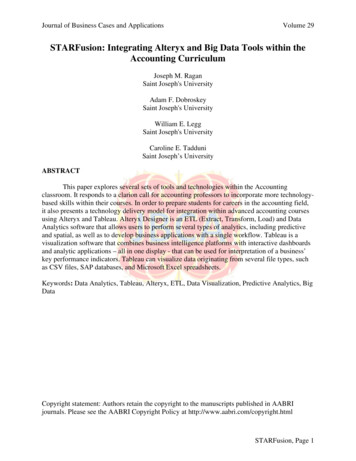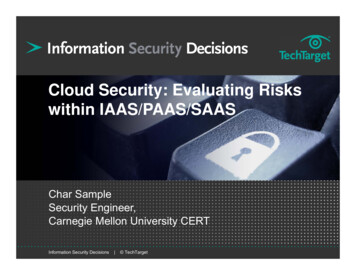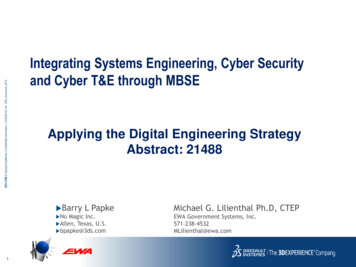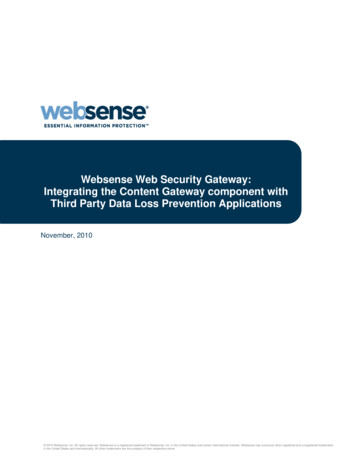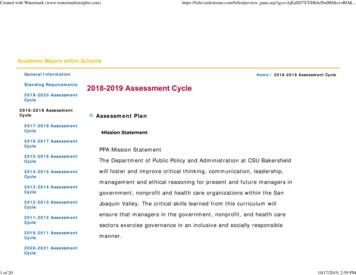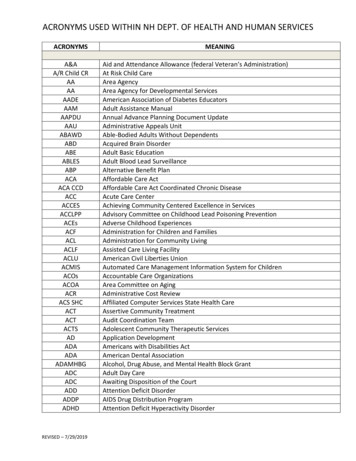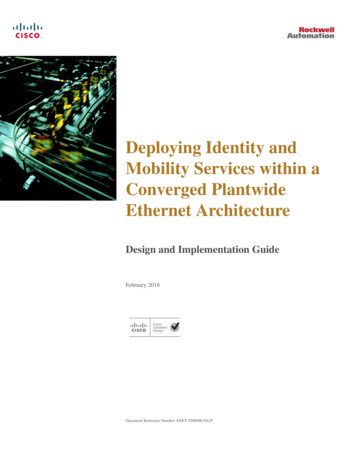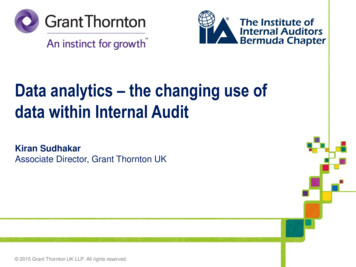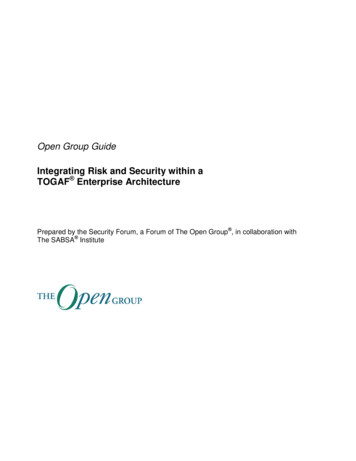
Transcription
Open Group GuideIntegrating Risk and Security within aTOGAF Enterprise ArchitecturePrepared by the Security Forum, a Forum of The Open Group , in collaboration withThe SABSA Institute
Copyright 2016, The Open Group. All rights reserved.No part of this publication may be reproduced, stored in a retrieval system, or transmitted, in any form or by any means,electronic, mechanical, photocopying, recording, or otherwise, without the prior permission of the copyright owner.This Guide has not been verified for avoidance of possible third-party proprietary rights. In implementing this Guide,usual procedures to ensure the respect of possible third-party intellectual property rights should be followed.Open Group GuideIntegrating Risk and Security within a TOGAF Enterprise ArchitectureISBN:1-937218-66-9Document Number:G152Published by The Open Group, January 2016.Comments relating to the material contained in this Guide may be submitted to:The Open Group, Apex Plaza, Forbury Road, Reading, Berkshire, RG1 1AX, United Kingdomor by electronic mail to:ogspecs@opengroup.orgiiOpen Group Guide (2016)
Contents123Introduction . 11.1How does this Guide Support the TOGAF Standard? . 21.2What about Risk Management? . 21.3Where is the Controls Checklist?. 3Relationship to Other IT Security and Risk Standards . 52.1 ISO/IEC 27001:2013: Information Security Management . 52.2ISO 31000:2009: Risk Management – Principles and Guidelines . 52.3National Cybersecurity Frameworks . 52.42.52.6COBIT . 6O-ESA. 6O-ISM3 . 62.7Open FAIR. 62.8SABSA . 7Enterprise Security Architecture . 83.1 Enterprise Risk Management . 93.1.13.2Definition of Risk . 93.1.2Core Concepts for Enterprise Risk Management . 11Information Security Management . 123.2.1Security. 123.2.2Privacy . 133.2.33.2.4Core Concepts for Information Security Management. 13Operational Security Processes . 154Security as a Cross-Cutting Concern . 165Security and Risk Concepts in the TOGAF ADM . 175.1 Preliminary Phase . 175.1.1Business Drivers/Business Objectives . 175.1.2Security Principles. 175.1.3Risk Appetite . 185.1.4Key Risk Areas/Business Impact Analysis . 185.1.5Security Resource Plan . 18Integrating Risk and Security within a TOGAF Enterprise Architectureiii
5.2Phase A: Architecture Vision . 195.3Phase B: Business Architecture . 205.45.3.1Security Policy Architecture . 205.3.2Security Domain Model . 205.3.3Trust Framework . 215.3.4Risk Assessment . 215.3.5Business Risk Model/Risk Register . 225.3.6Applicable Law and Regulation Register . 225.3.7Applicable Control Framework Register. 22Phase C: Information Systems Architectures . 235.4.1Security Services Catalog . 235.4.2Security Classification. 235.4.3Data Quality . 245.5Phase D: Technology Architecture . 245.6Phase E: Opportunities and Solutions . 255.6.1Risk Mitigation Plan. 255.7Phase F: Migration Planning. 255.8Phase G: Implementation Governance. 265.95.8.1Security Audit. 265.8.2Security Training and Awareness . 26Phase H: Architecture Change Management . 265.10 Requirements Management . 275.10.1Business Attribute Profile . 275.10.2Control Objectives/Security Objectives . 295.10.3Security Standards . 305.11 The TOGAF Architecture Content Metamodel . 305.12 Use of the ArchiMate Modeling Language . 30ivOpen Group Guide (2016)
PrefaceThe Open GroupThe Open Group is a global consortium that enables the achievement of business objectivesthrough IT standards. With more than 450 member organizations, The Open Group has a diversemembership that spans all sectors of the IT community – customers, systems and solutionssuppliers, tool vendors, integrators, and consultants, as well as academics and researchers – to: Capture, understand, and address current and emerging requirements, and establishpolicies and share best practices Facilitate interoperability, develop consensus, and evolve and integrate specifications andopen source technologies Offer a comprehensive set of services to enhance the operational efficiency of consortia Operate the industry’s premier certification serviceFurther information on The Open Group is available at www.opengroup.org.The Open Group publishes a wide range of technical documentation, most of which is focusedon development of Open Group Standards and Guides, but which also includes white papers,technical studies, certification and testing documentation, and business titles. Full details and acatalog are available at www.opengroup.org/bookstore.Readers should note that updates – in the form of Corrigenda – may apply to any publication.This information is published at www.opengroup.org/corrigenda.The SABSA InstituteThe SABSA Institute is the professional member and certification body for Enterprise SecurityArchitects of all specialisms and at all career levels. It governs the ongoing development andmanagement of SABSA intellectual property and the associated certification and educationprograms worldwide.The SABSA Institute envisions a global business world of the future, leveraging the power ofdigital technologies, enabled in the management of information risk, information assurance, andinformation security through the adoption of SABSA as the framework and methodology of firstchoice for commercial, industrial, educational, government, military, and charitable enterprises,regardless of industry sector, nationality, size, or socio-economic status, and leading toenhancements in social well-being and economic success.Further information on The SABSA Institute can be found at www.sabsa.org.Integrating Risk and Security within a TOGAF Enterprise Architecturev
This DocumentThis document is an Open Group Guide addressing how to integrate considerations of securityand risk into an Enterprise Architecture. It provides guidance for security practitioners andEnterprise Architects who need to work with TOGAF, an Open Group Standard, to develop anEnterprise Architecture. It has been developed and approved by The Open Group SecurityForum.Integrating security and risk management in Enterprise Architecture strongly supports The OpenGroup vision of Boundaryless Information Flow , by informing well-justified design decisions,which maximize business opportunity whilst minimizing business risk.This Guide is structured as follows: Chapter 1 provides a high-level introduction to this Guide, introducing the topic ofEnterprise Security Architecture, how it relates to Enterprise Architecture, and how thisGuide supports the TOGAF standard. Chapter 2 describes the relationship with other IT security and risk standards. Chapter 3 describes the concept of Enterprise Security Architecture in detail. It describesInformation Security Management (ISM) and Enterprise Risk Management (ERM), twoprocesses used by Security Architects. Chapter 4 describes Security Architecture, which is a cross-cutting concern, pervasivethrough the whole Enterprise Architecture. Chapter 5 explains in detail the core security concepts and how they can be applied foreach phase of the TOGAF ADM.The intended audience for this Guide is as follows: Enterprise Architects, Security ArchitectsConventions Used in this GuideThe following conventions are used throughout this Guide in order to help identify importantinformation and avoid confusion over the intended meaning: Ellipsis ( )Indicates a continuation; such as an incomplete list of example items, or a continuationfrom preceding text. BoldUsed to highlight specific terms. ItalicsUsed for emphasis. May also refer to other external documents.viOpen Group Guide (2016)
TrademarksArchiMate , DirecNet , Making Standards Work , OpenPegasus , The Open Group ,TOGAF , UNIX , and the Open Brand (“X” logo) are registered trademarks and BoundarylessInformation Flow , Build with Integrity Buy with Confidence , Dependability ThroughAssuredness , FACE , IT4IT , Open Platform 3.0 , Open Trusted Technology Provider ,and the Open “O” logo and The Open Group Certification logo are trademarks of The OpenGroup in the United States and other countries.COBIT is a registered trademark of ISACA, registered in the United States and other countries.SABSA is a registered trademark of SABSA Limited.All other brands, company, and product names are used for identification purposes only and maybe trademarks that are the sole property of their respective owners.Integrating Risk and Security within a TOGAF Enterprise Architecturevii
AcknowledgementsThe Open Group gratefully acknowledges the contribution of the following people in thedevelopment of this Guide (in alphabetical order): Geoff Besko, Seccuris: Co-lead Randy Caraway, HP Piotr Ciepiela, Ernst & Young Pascal de Koning, i-to-i: Co-lead Thorbjørn Ellefsen, DIFI Brian Golumbeck, HP Kirk Hansen, Kirk Hansen Consulting Jim Hietala, The Open Group: VP, Business Development and Security David Hornford, Conexiam Andrew Josey, The Open Group: Director, Standards Christian Mark, IBM Security: Co-lead Robert Martin, MITRE Martin W. Murhammer, IBM Matthew Olsen, Ernst & Young Miroslaw Ryba, Ernst & Young John Sherwood, Founder, The SABSA Institute: Lead SABSA Contributor John Sluiter, PricewaterhouseCoopers (PwC) Eric Stephens, Oracle Tony Yin, HPWhere appropriate, this Guide includes excerpts from the SABSA Blue Book [2] and theTOGAF and SABSA Integration White Paper [13], with the full approval and permission ofThe SABSA Institute.viiiOpen Group Guide (2016)
Referenced DocumentsThe following documents are referenced in this Guide:(Please note that the links below are good at the time of writing but cannot be guaranteed for thefuture.)[1]TOGAF Version 9.1, Enterprise Edition, Open Group Standard (G116), December2011, published by The Open Group; available ]SABSA Blue Book: Enterprise Security Architecture: A Business-DrivenApproach, by John Sherwood, Andy Clark, David Lynas, 2005.[3]The SABSA Institute: www.sabsa.org.[4]ISO/IEC 27001:2013: Information Security Management; refer ards/iso27001.htm.[5]ISO/IEC 27002:2013: Information Technology – Security Techniques – Code ofPractice for Information Security Controls; refer to:www.iso.org/iso/catalogue detail?csnumber 54533.[6]ISO 31000:2009: Risk Management – Principles and Guidelines; refer IEC 31010:2009: Risk Management – Risk Assessment Techniques; refer to:www.iso.org/iso/catalogue detail?csnumber 51073.[8]ArchiMate 2.1 Specification, Open Group Standard (C13L), December 2013,published by The Open Group; available ]Open Information Security Management Maturity Model (O-ISM3), Open GroupStandard (C102), published by The Open Group, February 2011; refer 0]Control Objectives for Information and Related Technology (COBIT ), Version5.0, IT Governance Institute, 2012.[11]An Enterprise Architecture and Data Quality Framework, Jerome Capirossi,NATEA Consulting and Pascal Rabier, La Mutuelle Generale, 2007; accessed .fr/wpcontent/uploads/2007/05/DEDM13 rk.pdf.Integrating Risk and Security within a TOGAF Enterprise Architectureix
x[12]Modeling Enterprise Risk Management and Security with the ArchiMate Language, White Paper (W150), published by The Open Group, January 2015; referto: OGAF and SABSA Integration: How SABSA and TOGAF complement eachother to create better architectures, White Paper (W117), published by The OpenGroup (October 2011); refer to pen Enterprise Security Architecture (O-ESA): A Framework and Template forPolicy-Driven Security, Open Group Guide (G112), published by Van HarenPublishing, April 2011; refer to: isk Taxonomy (O-RT) Version 2.0, Open Group Standard (C13K), published byThe Open Group, October 2013; refer ]Risk Analysis (O-RA) Open Group Standard (C13G), published by The OpenGroup, October 2013; refer to www.opengroup.org/bookstore/catalog/c13g.htm.Open Group Guide (2016)
1IntroductionEnterprise Architecture (including Security Architecture) is all about aligning business systemsand supporting information systems to realize business goals in an effective and efficient manner(systems being the combination of processes, people, and technology). One of the importantquality aspects of an Enterprise Architecture is information security and the way this can bemanaged. For too long, information security has been considered a separate discipline, isolatedfrom the business processes and Enterprise Architecture.A Security Architecture is a structure of organizational, conceptual, logical, and physicalcomponents that interact in a coherent fashion in order to achieve and maintain a state ofmanaged risk and security (or information security). It is both a driver and enabler of secure,safe, resilient, and reliable behavior, as well as for addressing risk areas throughout theenterprise.However, an Enterprise Security Architecture does not exist in isolation. As part of theenterprise, it builds on enterprise information that is already available in the EnterpriseArchitecture, and it produces information that influences the Enterprise Architecture. This iswhy a close integration of Security Architecture in the Enterprise Architecture is beneficial. Inthe end, doing it right the first time saves costs and increases effectiveness compared to boltingon security afterwards. To achieve this, Security Architects and Enterprise Architects need tospeak the same language. That language is introduced in this Guide, which describes how tointegrate security and risk into an Enterprise Architecture. It provides guidance for both securitypractitioners and Enterprise Architects working with TOGAF , an Open Group Standard [1], todevelop an Enterprise Architecture.Figure 1 summarizes this Guide. It shows how Enterprise Architecture and Enterprise SecurityArchitecture relate to each other, highlighting the core security and risk concepts that are used inInformation Security Management (ISM) and Enterprise Risk Management (ERM). Theseconcepts are listed in the center column, and form a set of foundation concepts that complementand enhance the TOGAF standard. Concepts with an underscore in the figure are additions to theTOGAF framework and brought in by ISM or ERM.Integrating Risk and Security within a TOGAF Enterprise Architecture1
Figure 1: Essential Security and Risk Concepts and their Position in the TOGAF ADM1.1How does this Guide Support the TOGAF Standard?This new content takes the security activities in the current TOGAF standard [1] to a higherconceptual level. The goal of this approach is to explain how the TOGAF method andframework can be tailored to make use of an existing Enterprise Security Architecture in order toaddress security and risk properly.This approach is business-driven and supports the integration of two processes: ISM and ERM.This process orientation will improve understanding of the security concepts and activities atdifferent phases through the TOGAF Architecture Development Method (ADM). The businessorientation will contribute to justification of the security components.In this approach, it is foreseen that a lot of additional security practitioner guidance needs to bedeveloped. This Guide provides the basis for that work. By using a common foundation this willdeliver an internally consistent and practical way of working.1.2What about Risk Management?Risk management in the TOGAF standard primarily focuses on architecture project risk. This isonly one type of risk. The scope of ERM, as presented in this Guide as part of the EnterpriseSecurity Architecture, is much broader. It includes business, system, information, project,privacy, compliance, and organizational change risk, among other categories, too.2Open Group Guide (2016)
This Guide describes the broader concepts of ERM and how to integrate them into the TOGAFstandard. In particular, this work focuses on all aspects of operational risk – the risks that abusiness faces in day-to-day operations that are based on operational capabilities that areproduced as the result of Enterprise Architecture work. It is intended that by paying moreattention to operational risk downstream of the delivery of Enterprise Architecture workproducts, the utility, quality, and effectiveness of those work products will be improved andenhanced.The Enterprise Security Architecture contains a balanced view on risk: negative consequencesare kept to an acceptable level and positive opportunities are exploited to their maximum. Thebusiness-driven approach is key for the Security Architecture: business drivers offer the contextfor risk assessments; they define whether compliance with any control framework is necessary,and they justify the need for security measures.This Guide is explicitly looking at risk within the context of best practice ERM. It is written forpractitioners who expect to use best practices and are prepared to read and consider carefully thelanguage within a profession. Like all professions, the risk management profession evolves andimproves. Central to best practice ERM is a very precise definition of the term “risk”. Over thelast 15 years risk management has moved the professional definition from thought leadership, toleading practice, to well established best practice. Risk definition is embedded withinmainstream risk management international standards, such as ISO 31000:2009 [6], best practiceguides, and derived industry-specific guides, such as the Global Association of RiskProfessionals Financial Risk Manager certification.There is a difference between the commonly accepted definition of “risk” and the riskmanagement professional definition of the term. Within the risk management profession “risk” isdefined to be the “effect that uncertainty has on the achievement of business objectives”. Formany information security practitioners, this definition can feel uncomfortable: In theirdiscipline, “risk” is usually regarded as threat-bound and therefore a negative attribute.Since this Guide is aimed at the core concepts of the TOGAF standard as an EnterpriseArchitecture framework, the definition of risk used is as defined in ISO 31000:2009. Thisdefinition allows for the usage of the term in subsequent practitioner guidance that focuses onlyon the narrower usage of risk as a negative; for example, in the information security riskmanagement area, where the uncertainties are generally always negative outcomes.1.3Where is the Controls Checklist?First of all, integrating security is not a matter of selecting controls from a checklist. Weadvocate a holistic approach towards security, so that a trustworthy, robust, reliable, secure, andrisk-managed architecture is delivered. To do this, the Enterprise Security Architecture makessure that tight cooperation is obtained between the ADM and the processes for ISM and ERM.Therefore, most of the security concepts in this Guide refer to things needed to set up securityproperly.However, designing the operational security is part of the architecture as well. In the architecturecontext, security controls are bundled into security services. A security service can be seen as anArchitecture Building Block (ABB). In the TOGAF standard, ABBs capture architecturerequirements that both direct and guide the development of Solution Building Blocks (SBBs).Integrating Risk and Security within a TOGAF Enterprise Architecture3
This can apply to all four of the TOGAF domain architectures: Business, Data, Application, andTechnology. In the same way, security services capture security requirements and guide thedevelopment of sub-services and components.Examples of security services are: Identity & Access Management Continuity Management Security Intelligence Digital Forensics Audit Network Monitoring Compliance Management Training & Awareness Programs, etc.The security services are positioned in the logical layer of the SABSA architecture framework,which is developed in Phase C (Information Systems Architectures) of the TOGAF ADM. TheSecurity Services Catalog provides the actual description of those security services.To support security practitioners in actually designing and using the security services, a SecurityServices Catalog is needed. For Security Architects, the Security Services Catalog is a registerthat supports filling in the logical layer of the SABSA architecture framework with securitycontrols. Unlike existing control frameworks that contain requirements, the Security ServicesCatalog describes security building blocks that actually deliver protection. This architectureapproach enables smooth integration of information security in the Enterprise Architecture.The standardized approach contributes to the professionalization of the security managementorganization and facilitates a more efficient, cost-effective way of working. One of the mainadvantages of the Security Services Catalog is that offers a common terminology and referenceframework for the domain of security management allowing better cooperation between theparties concerned.4Open Group Guide (2016)
2Relationship to Other IT Security and Risk StandardsThis chapter documents relationships among selected standards in this subject area.2.1ISO/IEC 27001:2013: Information Security Management“ISO/IEC 27001:2013 is a standard that specifies the requirements for establishing,implementing, maintaining, and continually improving an information security managementsystem within the context of the organization. This International Standard also includesrequirements for the assessment and treatment of information security risks tailored to the needsof the organization.” [4]The core concepts of ISO/IEC 27001:2013 are taken as a basis for the ISM process in this Guide.This explains a sound security management process and helps readers to understand the logicbehind specific risk concepts that are needed in the TOGAF framework. However, no fixedmapping has been made to that standard. It is seen as one of the good references that is veryuseful for this work.2.2ISO 31000:2009: Risk Management – Principles and GuidelinesISO 31000:2009 [6] sets out principles, a framework, and a process for the management of riskthat are applicable to any type of organization in the public or private sector. It does not mandatea “one size fits all” approach, but rather emphasizes the fact that the management of risk must betailored to the specific needs and structure of the particular organization. It has a related standardIEC 31010:2009 [7] that describes examples of qualitative risk assessment methods.The core concepts of ISO 31000:2009 are taken as a basis for the ERM process in this Guide.Just as with ISO/IEC 27001:2013, no fixed mapping has been made to that standard but it is seenas one of the good references that is very useful for this work.2.3National Cybersecurity FrameworksInternationally there are many country-specific cybersecurity standards. A leading example isthe NIST Cybersecurity Framework, introduced in 2014. This framework aims to helporganizations in critical infrastructure sectors to reduce risk, and protect their criticalinfrastructure. The NIST Cybersecurity Framework groups security functions into these fiveareas: Identify, Protect, Detect, Respond, and Recover. Many of the security and risk conceptsintroduced in this Guide and in future work (including the Security Services Catalog) will behighly useful to Security Architects in critical infrastructure areas seeking to integrate securityand risk into their TOGAF standard practices, and into their Enterprise Architectures.Integrating Risk and Security within a TOGAF Enterprise Architecture5
2.4COBIT “COBIT 5 provides a comprehensive framework that assists enterprises in achieving theirobjectives for the governance and management of enterprise IT. Simply stated, it helpsenterprises create optimal value from Information Technology (IT) by maintaining a balancebetween realizing benefits and optimizing risk levels and resource use. COBIT 5 for InformationSecurity builds on the COBIT 5 framework in that it focuses on information security andprovides more detailed and more practical guidance for information security professionals andother interested parties at all levels of the enterprise.” [10]COBIT 5 for Information Security is regarded as a relevant framework for security governance.However, in this Guide the structure of ISO/IEC 27001:2013 is used because that is a broaderrecognized definition of a security management system.2.5O-ESAThe Open Enterprise Security Architecture (O-ESA) standard [14], published by The OpenGroup in 2011, is a reference Security Architecture and guide to building a security program.While it contains useful information on information security governance, security principles, andtechnology components and services needed in Security Architectures, this referencearchitecture can be also applied to support the implementation of security and risk in EnterpriseArchitectures using the TOGAF standard.2.6O-ISM3The Open Information Security Management Maturity Model (O-ISM3) standard [9], publishedby The Open Group in 2011, describes a process-based approach towards building and operatingan Information Security Management System (ISMS). Successful operation of the ISMS isgenerally a prerequisite for Enterprise Architectures to meet the security objectives establishedby an organization. A chapter of the Security Architecture Practitioners Guide will be devoted tothe relationship between Enterprise Architecture, the TOGAF standard, and ISMSs. The O-ISM3standard defines security services as strategic, tactical, or operational processes, and provides ametrics-based approach to continuous improvement of the processes. Many of the services orprocesses described in the O-ISM3 standard are expected to be referenced in the SecurityServices Catalog Project as well.2.7Open FAIRThe Open FAIR Body of Knowledge comprises the Risk Taxonomy (O-RT) Standard [15] andthe Risk Analysis (O-RA) Standard [16
Integrating Risk and Security within a TOGAF Enterprise Architecture vii Trademarks ArchiMate , DirecNet , Making Standards Work , OpenPegasus , The Open Group , TOGAF , UNIX , and the Open Brand (“X” logo) are registered trademarks and Boundaryless Information Flow , Build w
